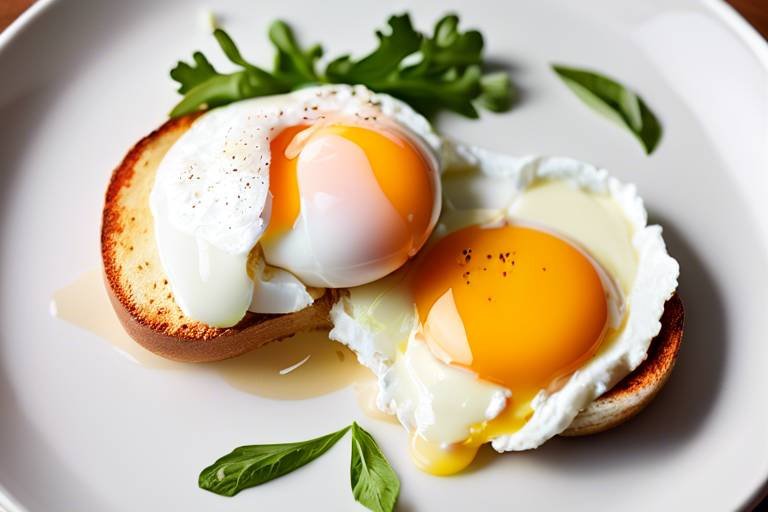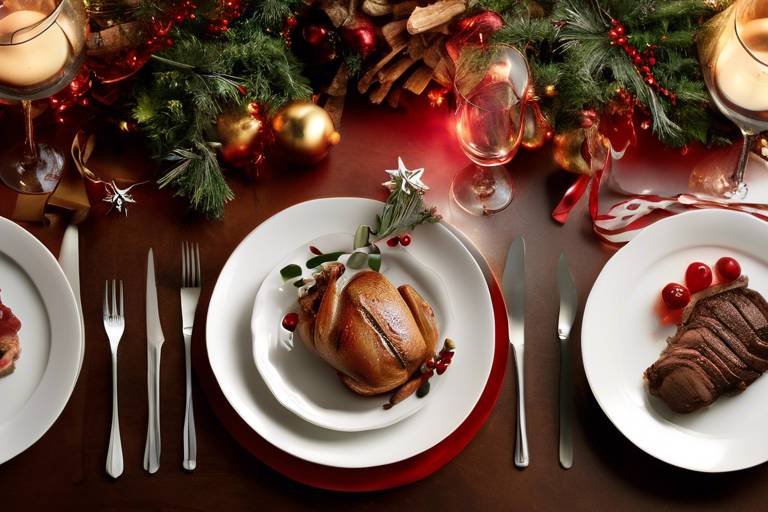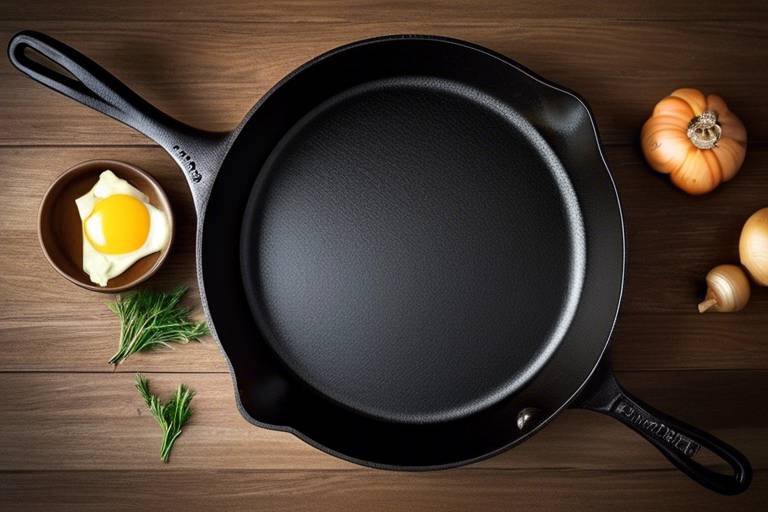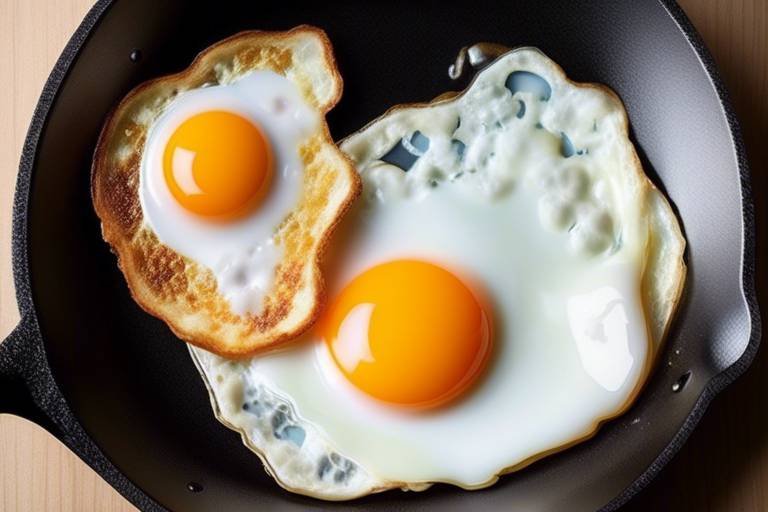How to Make the Perfect Poached Eggs Every Time
Have you ever tried to make the perfect poached eggs, only to end up with a messy, unappetizing result? Fear not, as mastering the art of poaching eggs is within your reach. With the right tips and techniques, you can achieve perfectly cooked poached eggs every time, ensuring a runny yolk and firm whites with each attempt.

Choosing the Freshest Eggs
When it comes to making the perfect poached eggs, the first step begins with choosing the freshest eggs available. The freshness of the eggs plays a crucial role in achieving the desired taste and appearance of the poached eggs. Fresh eggs have firmer whites, which help maintain the egg's shape during the poaching process, resulting in a beautifully cooked egg with a runny yolk.
To ensure you are using the freshest eggs for poaching, look for eggs with intact shells and check the expiration date on the carton. Fresher eggs will have a higher yolk that stands up more firmly, indicating their freshness. When cracking open a fresh egg, you will notice a compact white that holds its shape well, making it ideal for poaching.
Another method to determine the freshness of an egg is the water test. Fill a bowl with water and gently place the egg inside. If the egg sinks and lies flat on the bottom, it is fresh. In contrast, if the egg stands upright at the bottom or floats, it is not as fresh and should be avoided for poaching.

Preparing the Poaching Water
When it comes to poaching eggs, the quality of the water plays a crucial role in the final outcome. To prepare the perfect poaching water, start by selecting a shallow pan or pot that allows the eggs to cook evenly without overcrowding. The ideal water temperature for poaching eggs is around 180-190°F, just below boiling point, as this helps the eggs to set gently without becoming tough or rubbery.
One common technique for achieving the ideal poaching water is to add a splash of vinegar, which helps the egg whites coagulate faster and maintain their shape. The acidity from the vinegar also enhances the flavor of the eggs without overpowering them. Additionally, a pinch of salt can be added to the water to season the eggs subtly during the cooking process.
To create a whirlpool effect in the water before adding the eggs, gently stir the water in a circular motion using a spoon. This swirling motion helps the egg whites wrap around the yolk neatly, resulting in a more uniform and visually appealing poached egg. The whirlpool method is particularly useful for achieving a well-shaped poached egg with a runny yolk center.
Remember that the key to preparing the poaching water lies in maintaining a delicate balance of temperature and acidity. By following these tips and techniques, you can ensure that your poached eggs turn out perfectly every time, with a lusciously runny yolk and firm, glossy whites that are a delight to behold and savor.

Cracking the Egg Properly
Cracking an egg properly is a crucial step in the process of poaching eggs to ensure a successful outcome. The way you crack the egg can significantly impact the final result, affecting both the appearance and taste of the poached egg. When cracking an egg, it's essential to do it gently and with precision to avoid breaking the yolk and maintaining the egg's shape.
One effective technique for cracking an egg is to crack it on a flat surface rather than the edge of a bowl or pan. This method helps create a clean break without damaging the eggshell, reducing the risk of shell fragments ending up in the poaching water. Additionally, cracking the egg on a flat surface provides better control and allows for a smoother release of the egg into the water.
Another tip for cracking eggs properly is to crack them one at a time into a small bowl or ramekin before transferring them to the poaching water. This approach allows you to inspect the egg for any shell fragments or abnormalities before adding it to the water, ensuring a seamless poaching process without any unwanted surprises.
When cracking the egg, avoid using excessive force that could cause the yolk to break prematurely. A gentle but firm crack is all that's needed to create a clean opening for the egg to flow out smoothly. Remember, the goal is to keep the yolk intact during the poaching process to achieve that perfect, runny center that makes poached eggs so delicious.
Mastering the art of cracking eggs properly may take some practice, but it's a skill that can greatly enhance your poaching technique and elevate the overall quality of your poached eggs. So, next time you're preparing to poach eggs, pay attention to how you crack them—it could make all the difference in achieving the perfect poached egg every time.

Timing the Poaching Process
Timing plays a crucial role in achieving the perfect poached egg consistency. The ideal timing for poaching eggs depends on personal preference, whether you prefer a runny yolk or a firmer texture. To achieve a runny yolk with firm whites, a general rule of thumb is to poach the eggs for about 3-4 minutes. However, if you prefer a firmer yolk, you can extend the poaching time to 5-7 minutes. It's essential to keep an eye on the eggs while they are poaching to ensure they reach the desired doneness.
One popular method to check the doneness of poached eggs is the touch method. Gently press the poached egg with a spoon to assess the firmness of the whites and the yolk. For a runny yolk, the egg should feel soft and slightly jiggly, while a firmer yolk will have a more solid texture. Practice and experimentation will help you determine the perfect timing for poaching eggs to suit your taste preferences.
Factors such as the size of the eggs, the temperature of the water, and the freshness of the eggs can also influence the poaching time. Larger eggs may require slightly longer poaching times, while colder eggs straight from the refrigerator may take a bit longer to cook through. By adjusting these variables and observing the eggs during the poaching process, you can master the art of timing poached eggs to perfection.

Removing the Poached Eggs Correctly
When it comes to removing poached eggs correctly, the process requires a delicate touch to ensure that the eggs maintain their shape and presentation. One effective method is to use a slotted spoon to carefully lift the poached eggs out of the water. By gently draining any excess water on the spoon, you can prevent diluting the flavors of the poached eggs when transferring them to a plate.
Another technique for removing poached eggs without damaging them is to briefly place the spoon holding the egg on a clean kitchen towel. This allows the towel to absorb any remaining water, preventing it from spilling onto the plate and affecting the overall presentation of the dish. Ensuring that the poached eggs are not excessively wet before serving can elevate the visual appeal of the final dish.
For those who prefer a more hands-on approach, using a small bowl or ramekin to carefully lift the poached eggs out of the water can provide additional control during the removal process. By sliding the eggs gently onto the plate from the bowl, you can maintain their shape and prevent any unwanted splashing or breakage.

Serving Suggestions and Variations
When it comes to serving poached eggs, the possibilities are endless. Whether you prefer a classic presentation or want to get creative with your dish, there are numerous serving suggestions and variations to explore. One popular option is to serve poached eggs on top of toasted English muffins, topped with creamy hollandaise sauce, creating the beloved Eggs Benedict. This combination of flavors and textures is a brunch favorite that never disappoints.
For a lighter meal, consider serving poached eggs on a bed of fresh, peppery arugula, drizzled with a tangy vinaigrette dressing. The contrast of the warm, runny yolk against the crisp greens adds a delightful touch to a simple yet elegant dish. If you're feeling adventurous, try incorporating poached eggs into a salad with roasted vegetables, grains, and a zesty dressing for a wholesome and satisfying meal.
When it comes to variations, think outside the box and experiment with different ingredients to elevate your poached egg experience. Consider adding smoked salmon, avocado slices, or sautéed mushrooms to your poached eggs for a flavorful twist. You can also play with spices and seasonings, such as paprika, cumin, or fresh herbs, to enhance the taste profile of your dish.
To add a touch of luxury to your meal, try serving poached eggs with truffle oil drizzled on top, creating a decadent and indulgent treat. The earthy aroma of truffles pairs beautifully with the delicate texture of poached eggs, making it a sophisticated choice for a special occasion or a gourmet breakfast experience.

Troubleshooting Common Poaching Issues
When it comes to poaching eggs, there are common issues that can arise, causing frustration for even the most experienced cooks. One of the most frequent problems encountered is uneven cooking. This occurs when the egg whites spread out too much in the poaching water, resulting in some parts of the egg being overcooked while others remain undercooked. To prevent this, gently stir the water before adding the eggs to create a vortex, which helps the whites wrap around the yolk more evenly.
Another issue that can occur is wispy whites, where the egg whites separate and form thin strands in the water instead of enveloping the yolk properly. This can be caused by using eggs that are not fresh or by boiling the water too vigorously. To avoid wispy whites, make sure to use the freshest eggs possible and simmer the water gently before adding the eggs.
On the other hand, overcooked yolks are a common problem that can ruin the perfect poached egg experience. If the yolks are cooked for too long, they can become hard and lose their creamy texture. To prevent this, carefully monitor the poaching time and remove the eggs promptly once they reach the desired level of doneness.
Additionally, broken yolks can be a disappointment when poaching eggs. Cracking the egg too forcefully or dropping it from too high can lead to the yolk breaking before it even enters the water. To avoid this, crack the egg gently on a flat surface and lower it close to the water's surface when adding it to the pot.
Lastly, sticking eggs can be a frustrating issue when trying to remove poached eggs from the water. If the eggs stick to the bottom of the pot or to each other, they can lose their shape and presentation. Using a slotted spoon to gently lift the eggs out of the water can help prevent them from sticking and maintain their delicate form.

Practice Makes Perfect
When it comes to mastering the art of poaching eggs, practice truly makes perfect. Just like any skill, poaching eggs requires patience, persistence, and a willingness to learn from both successes and failures. It's about getting familiar with the process, understanding the nuances of timing and technique, and honing your skills through repetition.
Imagine yourself as a chef in a bustling kitchen, cracking eggs with confidence and effortlessly creating beautifully poached eggs every time. Each attempt brings you closer to perfection, allowing you to fine-tune your approach and adjust your methods based on the results. The more you practice, the more intuitive the process becomes, and soon enough, you'll be poaching eggs like a pro.
Don't be discouraged by initial setbacks or imperfect outcomes. Remember, even the most experienced chefs started somewhere, facing challenges and setbacks along the way. Embrace the learning curve, embrace the process, and most importantly, embrace the journey towards culinary excellence.
As you continue to practice and refine your poaching skills, you'll discover what works best for you, whether it's the perfect water temperature, the ideal swirling technique, or the precise timing for your preferred level of doneness. Each trial brings you closer to your goal, building your confidence and expertise one poached egg at a time.
Frequently Asked Questions
- How can I tell if an egg is fresh enough for poaching?
To check the freshness of an egg, you can perform a simple float test. Place the egg in a bowl of water - if it sinks and lays flat on its side, it's fresh. If it stands upright or floats, it's not as fresh and may not be ideal for poaching.
- Why is it important to add vinegar to the poaching water?
Vinegar helps the egg whites coagulate faster, resulting in a neater shape and preventing them from spreading out too much in the water. It also adds a subtle tangy flavor to the eggs, enhancing their overall taste.
- How can I achieve a perfectly runny yolk while ensuring the whites are fully cooked?
Timing is crucial when poaching eggs. For a runny yolk and firm whites, aim for about 3-4 minutes of cooking time. Adjust based on your preferences but remember that practice and experimentation will help you find the perfect balance.
- What should I do if my poached eggs keep breaking in the water?
Cracking the egg into a small cup before gently sliding it into the water can help maintain its shape. Additionally, ensuring the water is at a gentle simmer rather than a rolling boil can prevent the eggs from breaking apart.
- Can I prepare poached eggs in advance and reheat them later?
While poached eggs are best enjoyed fresh, you can prepare them ahead of time and store them in cold water until ready to reheat. To reheat, place them in hot water for a short time to warm them through without overcooking.



















